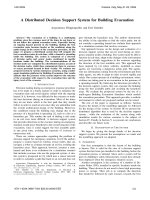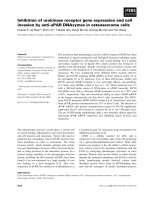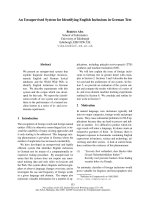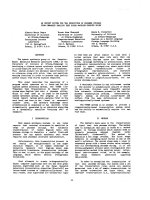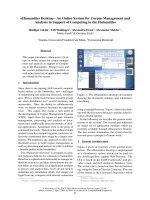Báo cáo " A web-based decision support system for the evaluation and strategic planning using ISO 9000 factors in higher education " pot
Bạn đang xem bản rút gọn của tài liệu. Xem và tải ngay bản đầy đủ của tài liệu tại đây (305.85 KB, 12 trang )
VNU Journal of Science, Mathematics - Physics 24 (2008) 197-208
197
A web-based decision support system for the evaluation and
strategic planning using ISO 9000 factors in higher education
Pham Van Hai
1,
*, Vatcharaporn Esichaikul
2
1
IT Division, Faculty of Education, VNU, 144 Xuan Thuy, Cau Giay, Hanoi, Vietnam
2
Computer Science and Information Management, Asian Institute of Technology
Received 30 November 2008
Abstract. ISO 9000 standard which is playing a significant role in higher education is originally
began for universities and institutes in the training international standard. Evaluating and planning
strategies have the key roles in a university for the development of educational management. Web-
based Decision Support System (DSS) can be used as an evaluation tool as well as a strategic
planning tool for schools / universities. Currently, there are few studies in DSS using a domain of
ISO 9000 in a traditional education. Compared with some algorithms of DSS, Analytic Hierarchy
Process (AHP) is a good candidate to solve problems in planning strategies in a university
management. Based on AHP model, this study focuses on using ISO 9000 factors of higher
education in order to build Web-based DSS application applied in a university in Vietnam. The
Web-based DSS application helps educational leaders make better decision for an evaluation and a
strategic planning in educational management. For the system implementation, Web-based DSS
application was developed for a case study of Vietnam National University Hanoi.
Keywords: Web-based decision support system, decision support system, planning strategy, ISO
9000 standard, evaluation, and educational management.
1. Introduction
Vietnam has officially joined in the member of World Trade Organization (WTO) since 2006.
The International Standards Organization - ISO 9000 standard which is playing significant role in
higher education was originally began for organizations and institutions in the training educational
standard [1]. Since the early 1990s, ISO 9000 certificate for an education or training organization
provided “assurance” that it is well organized and qualified the outcomes of educational standard
[2,3]. How to apply DSS model based on ISO 9000 factors in evaluation and strategic plan
development of educational institutions effectively is a challenging area for educational experts since
they are mainly using traditional methodologies for evaluation of educational management. In some
cases, educational leaders have some troubles in evaluating institutions as well as a strategic university
planning.
______
*
Corresponding author. E-mail:
P.V. Hai, Vatcharaporn Esichaikul / VNU Journal of Science, Mathematics - Physics 24 (2008) 197-208
198
Currently, there are few studies using ISO factors in order to evaluate schools / universities and
plan for a strategy in educational management of organizations in Vietnam and Asia [3]. However,
there are no DSS applications to apply a real case in the domain of an evaluation and a strategic
planning. For solving the problem, the first study step of this study focuses on analyzing ISO factors
for a DSS model in educational management. The second step of this study is to find out good
techniques in DSS. The third step of this study is to make the best model using ISO 9000 factors. The
forth step is to analyze the hierarchy model using ISO 9000 factors for an evaluation and a strategic
planning. The final step is to build a Web-based DSS application based on AHP model for an
evaluation and a strategic planning of a university.
Analytic Hierarchy Process (AHP), developed by Thomas L. Saaty [4], is one of several useful
models in decision making for DSS. AHP models are structured by decomposing a problem into a
hierarchy of elements such as attributes and alternatives influencing a system by incorporating levels:
objectives, attributes, sub attributes and alternatives [4,5]. The purpose of this study is to develop
Web-based DSS application using ISO 9000 factors for an evaluation and a strategic university
planning. For the implementation, a Web-based DSS is based on ISO 9000 factors for the evaluation
and strategic planning for a case study of Vietnam National University Hanoi (VNU).
2. Background an AHP and ISO 9000
2.1. Overview of ISO 9000 quality system standard
ISO 9000 is a core of educational quality system elements which are standards as a single system
originally designed to cover all manufacturing in service industries, and education and training [2,6].
In addition, ISO 9000 is a series of generic international standards developed by the International
Organization for Standardization for Quality Management and Quality Assurance [2,7].
The ISO 9000 series cover a broad scope of quality system elements and consist of five standards:
ISO 9000-1, ISO 9001, ISO 9002, ISO 9003 and ISO 9004-1 [1,2]. Currently, ISO 9000 standards
have been adopted by more than 74 countries as national standards for quality assurance. The
representative of ISO for the USA is the American National Standards Institute (ANSI) and the ISO
9000 series is administered by the American Society of Quality Control (ASQC) [2]. Management
responsibility is central to ISO 9000 series, which is the highest for the total quality system. A key
management responsibility of setting up a quality system is defined as a quality policy in higher
education. Trainers and educators manage the review processes so that it follows the basic principles
of evaluation in education system. As applied to educational institutions, the implementation of ISO
9000 is relied on significant ISO 9000 factors in educational management in order to evaluate or make
a strategic planning of the institutions.
2.2. Overall AHP model using ISO 9000 factors
For the evaluation and strategy planning of university using ISO 9000 factors, the study analyzes
ISO factors based on AHP model. In fact, the AHP is a systematic procedure for presenting the
elements of any problem hierarchically. The structure model identifies the hierarchical factors for its
smaller constituted parts and guides decision makers of pairwise comparison judgments to express an
P.V. Hai, Vatcharaporn Esichaikul / VNU Journal of Science, Mathematics - Physics 24 (2008) 189-200
199
impact of the elements in the hierarchy. Fig. 1 shows the overall model of Analytic Hierarchy Process
(AHP) using ISO 9000 factors in an evaluation and a strategic planning for educational management.
Fig. 1. Structure model of the AHP hierarchy.
The structure of AHP model is divided into three primary levels as follows:
Level 1 – Objectives: A strategic university plan / evaluation model using ISO 9000 factors of
educational management in a university.
Level 2 – Criteria: They include both factors and sub factors analyzed in AHP hierarchy.
Level 3 – Alternatives: Choosing the best choice decision among alternatives for an evaluation
model / a strategic university planning.
3. DSS model application for an evaluation and a strategy planning
3.1. Application model using ISO 9000 factors for a strategic planning
In a case study of Vietnam National University Hanoi, the AHP model using ISO 9000 factors is
applied in Faculty of Education, where the faculty will be a College of Education (COE) in the near
future. COE will have a strategic plan in higher education focusing on ISO 9000. Fig. 2 shows AHP
model using ISO 9000 factors in the case of study. The first level is the objective for choosing the best
strategic planning of COE in the future. The second level is the primary factors as a group of criteria
in which the factors (LV1, LV2, …LV9) are influent to the formulation of the sub criteria. In this
level, the subcriteria (LV11, LV12, …, LV91) encompass possible evaluation options required to be
selected to reflect the primary factors. For the alternative level, COE will choose the best strategic
planning among four alternative choices.
A fast model (planning in 1 – 2 years) is to change quickly a strategy in university development
for COE in higher education. In this case, it is necessary to drop almost traditional educational
management methods. To adapt rapidly the teaching, learning methods and total quality management
will be focused on ISO 9000.
Objectives
LV1
A1
…
…
…
…
…
…
LV2
LV8
LV9
LV9’
LV8’
LV2’
LV1’
A
2
A
n
-
1
A
n
Level 3
Alternatives
Level 1
Focus
Level 2
Criteria
P.V. Hai, Vatcharaporn Esichaikul / VNU Journal of Science, Mathematics - Physics 24 (2008) 197-208
200
Fig. 2. AHP model using ISO 9000 factors of COE.
LV1.
Management
Responsibility
LV2.
Quality System
LV11- Mission/ Policy Statement
LV12-Procedure Review Statement
LV13 - Work Instructions
LV14 - Quality Review
LV21 - Market research
LV22 - Teaching and assessment
LV23 - Course outlines
LV24 - Course outcomes
LV25 - External resources
LV3. Contract
Review
LV31 - Customers’ requirement
LV32 - Customer feedback
LV4.
Design Control
LV41 - Curriculum plans
LV42 - Course plans
LV43 - Learning resources
LV44 - Assessment courses
LV5. Purchasing
and Purchaser-
supplied product
LV52-The standard and performance
requir
ed
LV6.
Process Control
LV61 - Teaching methods
LV62 - Learning methods
LV63 - Monitoring student progress
LV64-Assessment of the student
LV65 - Feedback to the student
LV7. Internal
quality audits
LV71 - Self-improvement TQM
LV72 - Quality record
LV8. Corrective
action
LV81
-
Make decisions
LV82- Corrective Procedure change
LV9.
Training
LV91
-
Training Quality
LV92
-
Training customer’ needs
G
G
O
A
L
A FAST
MODEL
A
NORMAL
MODEL
A SLOW
MODEL
NO
MODEL
LV51
-
Maintaining items safe
t
y
P.V. Hai, Vatcharaporn Esichaikul / VNU Journal of Science, Mathematics - Physics 24 (2008) 189-200
201
A normal model (planning in 3-4 years) is to reform the organization combining with the
strategy of Total Quality Management (TQM) evaluation model applying in COE. The model can be
combined with traditional educational management.
A slow model (planning in 5-6 years) is very slow to progress a strategic planning since there are
many objectives and subjective factors that make a planning different to apply ISO 9000. Some
educational leaders do not want to adapt with the new model because of difficulty in improvement for
all college activities following the international standard.
No Model focuses on educational leaders’ decision, not allowing to apply a strategic planning in a
College / School using ISO 9000 factors because of an insufficient international standard resources.
For instance, lack of funding, good staffs and good instructors are significant factor to mainly affect a
model.
3.2. Application model using ISO 9000 factors for evaluation of educational management
At present, Vietnam National University Hanoi is the largest university which belongs to multi-
disciplinary type of university. Based on the model of ISO 9000 factors – international standard in
higher education of Vietnam, the hierarchy model using ISO 9000 factors in education of Vietnamese
universities consists of 9 categories (Management Responsibility, Quality System, Contract Review,
Design Control, Purchasing and Purchaser-supplied product, Process Control, Internal quality audits,
Corrective action, and Training) and 29 factors. Fig. 3 shows the overall model of Analytic Hierarchy
Process (AHP) using ISO 9000 factors in evaluation of educational management.
Alte
Fig. 3. AHP Model using ISO 9000 factors in evaluation of schools.
Figure 3 shows the first level of the structure which is the purpose of model in order to evaluate an
international standard in higher education of schools / colleges using ISO 9000 factors of VNU. The
second level is the primary factors as a group of criteria in which the factors (LV1, LV2, …LV9) are
influent to the formulation of the sub criteria. In this level, the subcriteria (LV11, LV12, … LV91)
encompass possible evaluation options required to be selected to reflect the evaluation of an
international standard in higher education in VNU. For the alternative levels, a case of study is
Objectives
LV1
School A1
…
…
…
…
…
…
Level 2
Criteria
level
LV2
LV8
LV9
LV91
LV83
LV12
LV11
School A
2
School A
n
-
1
School A
n
Level 1
Focus
Level 3
Alternatives
P.V. Hai, Vatcharaporn Esichaikul / VNU Journal of Science, Mathematics - Physics 24 (2008) 197-208
202
evaluated among faculty / college (A1, A2, … An) alternatives of VNU and consider which faculty /
college is carrying out the best evaluation of international standard in higher education based on ISO
9000 factors.
3.3. Decision making in group decision support systems (GDSS) for VNU
Based on ISO 9000 factors for a case study of VNU, the factors will be analyzed by the VNU
domain that focuses on an international standard in order in enhance higher education quality of the
university. For decision making process, DSS / GDSS is a good solution to evaluate the domain of
VNU which is shown in Fig. 4.
Fig. 4. VNU strategic plan / evaluation model in DSS environment.
Basic requirements of VNU evaluation and a strategy planning model based on ISO 9000 factors
are as follows:
Domain: The goal of the DSS is to choose the best strategic plan among proposed long-term plans
of VNU. In evaluation model, the best school / university is to applly ISO 9000 factors in VNU.
AHP model application: identification of the application model based on system capabilities,
assessment of input data and suggestion DSS design application.
Implementation: Web-based DSS application is a main implementation part for AHP model
application.
Outcome evaluation: Results are measured and interpreted by the construction of the DSS.
Choosing the best strategy plan model of university is based on ISO 9000 factors.
DSS Environment
Evaluation &
A Strategic Plan
Domain
AHP model
application
Outcome
Evaluation
DSS/ GDSS
ISO
9000
Factors
Implementation
Decision
Making
P.V. Hai, Vatcharaporn Esichaikul / VNU Journal of Science, Mathematics - Physics 24 (2008) 189-200
203
According to VNU evaluation and a strategic planning model, decision maker can choose the best
alternative choice using ISO 9000 factors in schools / colleges. However, groups are better than
individuals in understanding problems and catching errors. Working in a group can be divided by
different GDSS purposes such as top administrations, staffs and instructors.
3.4. Data collection
VNU educational experts answer survey questionnaires for an evaluation or a strategic planning of
educational management. Designing questionnaire’ survey is a very important step to match with AHP
model using ISO 9000 factors. Schools / Colleges can choose either a DSS or GDSS for decision
making of the Web-based DSS application. The main step of data collection can be divided into
several steps. Firstly, questionnaires are used for collecting data through direct interviews or paper-
based forms. Group interviews can be divided into some groups such as educational experts, dean,
staff and instructor groups. Secondly, the questionnaires are pre-tested before they become standard
questionnaires used for survey. During pre-testing the questionnaires, it is necessary to check AHP
model that consists of criteria built as well as comprehensive questionnaire instructions. Finally, the
questionnaires are sent to VNU by email for data collection. Data evaluation uses the collected data
through email questionnaires. After calculating the average of each question, data are inputted into
Web-based DSS application.
4. Architecture of Web-based Decision Support System
4.1. Prototype of the system
In order to present a logical model of the system, the flowchart of Web-based DSS application is
presented as shown in Fig. 5.
The whole system can be presented details for the prototype of Web-based DSS application. Web
interface is described in login process steps of the system. System and evaluation modules include
input steps and AHP algorithm processing of Web-based DSS application. For the web interface,
admin user either can login to the system or view DSS results on website. The system module will
verify the account authorized information as well as check its username and password for the
permission of the system. All logical modeling steps of the system module can be shown as follows:
Menu control system: The user can view DSS list results or input a new DDS application.
Input data module: The user can construct AHP model based on input factors as well as identify
the problem decomposition and hierarchy model in order to input numerical data into AHP
comparison matrix.
Evaluation module: It is described inside the mechanism of AHP as well as the process of the
system in order to view a DSS result.
P.V. Hai, Vatcharaporn Esichaikul / VNU Journal of Science, Mathematics - Physics 24 (2008) 197-208
204
Fig. 5. The logical modeling of Web-based DSS application.
4.2. System architecture
The recent development of the web generates further momentum to the design and implementation
of a support system. Web-based DSS is to provide a way for storing, presenting, gathering, sharing,
processing, and using information. Web-based DSS is also to provide a distributed infrastructure for
P.V. Hai, Vatcharaporn Esichaikul / VNU Journal of Science, Mathematics - Physics 24 (2008) 189-200
205
information processing, interaction and tool with user-friendly interface. This allows users to access
the system remotely and instantly at anytime, anywhere. Fig. 6 shows the system architecture for a
case study of VNU.
Fig. 6. The architecture of web-based DSS application.
Web-based DSS is based on Client / Server model on the Internet, which is included in all
characteristics of decision support system. Currently VNU has a good network infrastructure
connected all campuses through the Intranet/ Internet. Hence, Web-based DSS application is a good
solution as intelligent web application can be useful for the case of study to implement its application
on Vietnam National University Hanoi network. Schools or Colleges of VNU can be applied either an
evaluation or a strategic planning using ISO 9000 factors. The implementation on Web-based
application is demonstrated via a Website at
5. Result evaluation, conclusion and future works
5.1. Result evaluation
According to a case study of COE, VNU, decision maker can create a new DSS for a strategic
planning via the Internet with different purposes in educational management. AHP model has the
priority of each element that is weighted by the priority of its corresponding higher level element
which was used as the criteria in making the parities comparison. This procedure is continued by
moving downward along the structure of hierarchy, computing the weight of each element at every
level and using them to determine composite weight for succeeding levels, resulting in a composite
priority vector for the lowest level of the AHP hierarchy. Fig. 6 shows the result of a strategic planning
for College of Education, VNU.
Input
Data
Module
AHP
Matrix
Explanation
Module
The
progress
of DSS
system
P.V. Hai, Vatcharaporn Esichaikul / VNU Journal of Science, Mathematics - Physics 24 (2008) 197-208
206
Fig. 7. Result of strategic planning using ISO 9000 factors.
A Web-based DSS shows a real-time result as follows: a fast model is the best choice of the
strategy planning since the priority (0.4885) is the highest. The second best model is a normal model
(0.2621); the third choice (0.1477) is a slow model and the last model (0.1014). The strategy planning
of COE, VNU can be shown as a graph from the result of Web-based DSS application in Fig. 7.
Fig. 8. The result of graph view in planning strategies based on ISO 9000 factors of COE, VNU.
For evaluation of schools / colleges using ISO 9000 factors, a group of experts answer
questionnaire. Data are inputted in to Web-based DSS application as shown results of DSS via website
A
graph view
of
Web
-
based DSS
Scale of priorities
A Fast
Model
0.4785
A Normal
Model
0.2516
A Slow
Model
0.1577
No
Model
0.112
P.V. Hai, Vatcharaporn Esichaikul / VNU Journal of Science, Mathematics - Physics 24 (2008) 189-200
2
07
5.2. Conclusions
This is the first study applied Web-based DSS application for an evaluation and a strategic
planning of educational management in Vietnam. This study has contributed in effective evaluation for
educational management using ISO 9000 factors, and showed the successful result for a case study of
VNU as well as the development of Web-based DSS in educational management of a university.
ISO 9000 has a significant role in the development of Vietnamese universities. In Vietnam,
currently both national and private universities have used ISO 9000 for a vision as long-term strategies
in higher education. ISO 9000 factors are analyzed into the hierarchy model using TQM factors. DSS
application helps educational leaders choose the best appropriate evaluation model based on ISO 9000
factors. The result of research is a good solution for educational leaders to decide the best appropriate
evaluation model in future.
Among DSS algorithms, Analytic Hierarchy Process (AHP) is used to support decisions in a
strategic planning of educational management. This study focuses on using AHP in order to build a
Web-based DSS application based on ISO factors in a strategic planning. The DSS application helps
educational leaders choose the best strategy model among multiple planning choices (a fast model, a
normal model, a slow model and no model) in applying ISO 9000.
Web-based DSS application is a good solution shows complex functions of the system with a
convenient web service application. The system allows a decision maker to easily decide or create a
new model application on the Intranet/ Internet. The Web-based DSS application implementation has
completed successfully using full features of Web-based DSS application for various purposes in
educational management. In addition, the Web-based DSS application has implemented in a good
security on web application standard so that the application can be applied in most colleges of VNU as
well as Vietnamese universities in the future. According to VNU training model, the system can apply
all hierarchy model using a variety of ISO 9000 factors with different purposes.
The study has opened a new way for Web-based DSS application to be applied in educational
management. Clearly, the development of Web-based DSS application is very significant for
Vietnamese universities nowadays because DSS can be helpful to support the decision of the strategy
planning development in educational management.
5.3. Recommendation for future works
This study is applied AHP model for semi-structured decision making in evaluation and planning
strategies of educational management. ISO 9000 factors can be presented in AHP model in the
hierarchy model. In some complex cases of decision making, decision factors might be depended on
each other. The AHP model with feedback and factor dependency can easily deal with all aspects of
factors and alternatives involved in the decision process. The Analytic Network Process (ANP)
technique assumes dependency of factors on alternatives being considered. Therefore, solving problem
in communicated cases in educational management needs to combine both AHP and ANP techniques.
AHP model using ISO factors can be applied to many types of decision making in educational
management such as prediction, forecasting, planning and evaluation. For further development of DSS
application, AHP model will be easily adapted to another domain in real-time applications.
P.V. Hai, Vatcharaporn Esichaikul / VNU Journal of Science, Mathematics - Physics 24 (2008) 197-208
208
References
[1] Corrigan J.P., “ISO 9000 The Path To TQM”, Quality Progress Vol. 27 No. 5 (1994) 33.
[2] Thomas Crowe J., S. James Noble, “Architecture of ISO 9000 quality system Standards (Multi-attribute analysis of
ISO 9000)”, Columbia, Missouri, USA and Jeevan S. Machimada (1997)
[3] Tran Khanh Duc, “TQM/ISO 9000 in higher education in Vietnam” (2006)
[4] Saaty T.L, “The Analytic Hierarchy Process”, Mc. Graw. Hill. New Jork (1980).
[5] Jose L.S., I Herrero, “An AHP-based Methodology to Rank Critical Success Factors of Executive Information
Systems”, Computer Standard and Interfaces Vol. 28 (2005), (2004) 5.
[6] Davies,L. B. Ellison, School Leadership For The 21st Century (1997)
[7] Omar E. M. Khalil, “Information Systems and Total Quality Management: Establishing the Link”, College of
Business& Industry, UMASS, Dartmouth, MA. 02747, (2002).
[8] Careemers B.P.M, Schools effectiveness: effective instruction as an imperial contribution to improvement of education
in the class room, The Hague: SVO (1991)
[9] Deming W.E., Out of the Crises, MIT Cases, Cambridge, Mass (1996)
[10] Damrong Thawesaengskulthai, “Application of TQM & ISO Concepts for QA System Development in Higher
Education of ASEAN University Network (AUN-QA) and CU-QA 84” (2004)
[11] Feigenbaum A.V., Total Quality Control, November-December (1956) 93.
[12] Nadler D.A, M.L. Tushman, “A model for diagnosing organizational behavior”, Organizational Dynamics 9 (1980) 9.
[13] Myer M.W., L.G. Zucker. “Permanently Failing Organizations”, Beverly Hills, CA: Sage (1989).
[14] Le Duc Ngoc, “Training quality and quality assurance in Vietnam higher education”, VNU Education conference
(2006)
[15] Bruce L. Golden, Edward A.Wasil, Patrick T.Harker (Eds.). “The Analytic Hierarchy Process: Applications and
Studies”, Springer – Verlad Berlin . Heidelberg (1989)
[16] King J., “Quality Conscious”, Computer world July 19, 1993a (1993) 89.
[17] Keen P.G.W, , M.S. Scott-Morton, “Decision Support Systems”, An Organizational Perspective. Reading. MA:
Addison_Wesley (1978).
[18] Aleamoni L.M, R.E Spencer, “The Illinois Course Evaluation Questionnaire: a description of its development and a
report of some of its results”, Educational and Psychology Measurement 33 (1973) 669.
[19] Alma Harris, Nigel Bennett, Margaret Preedy. “Organizational effectiveness and improvement in education”, The Open
University, Celtic Court 22 Ballmoor Buckingham MK18 1XW (2000) 114.
[20] Saul L.Gass “Decision Making Model Algorithms”, John Wiley & Son, Inc. ISBN 0- 471-80963-2 (1985).
[21] Scott B. Parry, “Evaluating the Impact of Training: A collection of tools and techniques”, Publishing by the American
Society for Training & Development ISDN: -56286-063-1 (1997) 185.
[22] Stephen Murgatroyd, Colin Morgan, “Total Quality Management and the School ”, ISBN 0-335-15723-8, Open
Univeristy Press 22 Ballmoor Buckingham MK181XW (1994) 59.
[23] Tayler, “Additional Notes dealing with total quality management”, EDAS 314 and 414 Leadership and Organizational
Effectiveness resource book (2001)
[24] Alan Brown, Ton van der Wiele, Australian Journal of Management Vol. 21, No. 1, June (1996) © The University of
New South Wales.
[25] Tony Bush, Les Bell, Ray Bolam, Ron Glatter, Peter Ribbins, “ Educational management in a redefining theory, policy
and practice” (1999)
[26] Turban E., E.A Jay, T.P. Liang, “Decision Support Systems and Intelligent Systems”, Decision Support Systems: An
overview (2007) 137.
[27] Tribus, Myron, “Ten Management Practices” Total Quality: Principles and Practices withthin Organizations. Coral
Springs, p. IV, 19, (1992)
[28] Alter S.L, Decision Support System: Current Practices and Continuing Challenges, Reading, MA: Addison-Wesley,
(1980)
[29] Ralph G.Lewis Douglas H.Smith, “Total Quality in Higher Education”, Frank Voehl (1997) 85.
[30] Roger Ellis, “Quality Assurance for University Teaching”, The Society for Research into Higher Education & Open
University Press (1993) 100.

